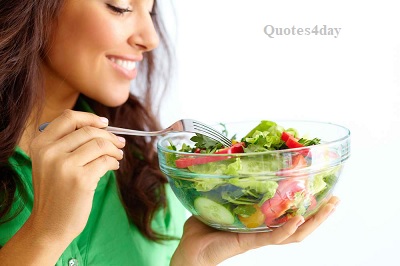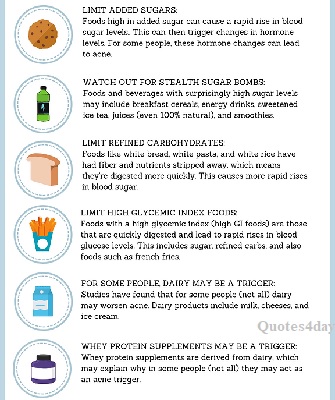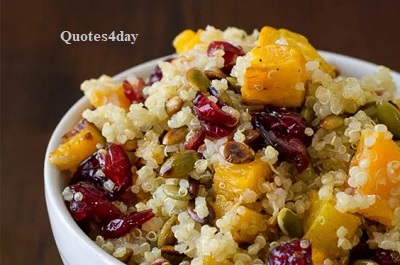Skin problems are faced by both teenagers and adults. Most often, rashes cannot be completely cured because they are genetic in nature, but they can be corrected with proper care and nutrition.

How to improve your skin healthy with nutrition
Beauticians and dermatologists, in addition to medical procedures and proper home care, recommend that people with problem skin adhere to a low-carbohydrate diet. Also, it is necessary to add foods to the diet that help reduce the intensity of sebum secretion and reduce its density.
Diet tips for problematic skin:
- Reduce the intake of carbohydrates and saturated fats;
- Increase your intake of fiber and antioxidants.
Creating a Healthy Diet Plan for Acne
natural probiotics. Sometimes the cause of rashes can be an imbalance in the intestinal microflora, which leads to inflammatory processes in the body and, as a result, the appearance of acne. Probiotic foods, such as fermented or pickled vegetables, help fight inflammation.
Fish and omega 3. Among the fatty acids, most often in our diet, there are a lot of omega 6. For all their health benefits, they are bad for the skin, because they contribute to inflammatory processes. Therefore, in the presence of acne, it is not recommended to consume a large amount of omega 6. To balance the diet, you should add more omega-3 fatty acids to it, which prevent clogging of pores and have an anti-inflammatory effect.

What foods to look for omega 3 in:
- Fatty sea fish: tuna, mackerel, sardines, cod liver;
- Vegetable products: flax seeds and oil, Brussels sprouts, broccoli.
Products containing zinc. This element is often used in medicinal creams and ointments. But it is also important to consume it in sufficient quantities with food:
- Chicken liver and hearts;
- Beef tongue and liver;
- Pecans and pine nuts;
- Oysters;
- Pumpkin seeds.
Antioxidants . Green tea is a powerful antioxidant that helps protect the body from the negative effects of free radicals. Drink it all day long, hot or cold, with lemon, mint, and other natural flavors. Just do not put sugar in a cup and choose tea not in bags, but loose.
With acne, it is also recommended to consume more dark berries (blueberries, currants, raspberries), which are rich in antioxidants and improve skin condition.
Vegetables and greens. A sufficient amount of fiber in the diet supports the normal functioning of the intestines, and the vitamins and minerals contained in vegetables are necessary for the whole organism. Therefore, everyone needs to have as many vegetables and herbs as possible in their diet. And for people with problem skin – vegetables rich in beta-carotene (provitamin A), which helps to naturally regulate oily skin and fight inflammation.
What are these products:
- Sea buckthorn;
- Carrot;
- Celery;
- Parsley.
Drinks. Instead of coffee in the morning, it is better to drink green tea, and instead of soda or packaged juice, clean water. Not only the skin, but the whole body will thank you for it.
What products to refuse
First of all, from those that enhance the work of the sweat and sebaceous glands:
- Foods with a high glycemic index, the so-called “fast carbohydrates”, dramatically raise blood glucose levels. This is anything that is low in fiber and high in added sugar: confectionery, white flour baked goods, sugary sodas, etc. A spike in blood glucose leads to increased production of insulin, which, in turn, stimulates the production of testosterone – one of the culprits of inflammation on the skin.
- Dairy and dairy products. For all their benefits, kefir, yogurt, cottage cheese, and milk contain bovine growth hormones, which are “included” in our hormonal processes and can cause acne.
- Anything that contains trans fats: processed foods, fast food, fried foods. They tend to make sebum thicker and denser, thus contributing to clogged pores.
- Alcohol provokes acne and irritation, leads to the formation of edema, and removes water from the body. Therefore, it is better to refuse its use altogether or at least minimize it.
Dishes for problem skin
For breakfast, you can eat:
- Muesli with dried berries and seeds;
- Oatmeal on the water with the addition of dried fruits;
- Wholemeal bread with avocado and salmon;
- Boiled egg.

Dinner options:
- Boiled or baked fish: sardines, mackerel, tuna;
- White meat or beef – steamed, baked, or stewed;
- Low-fat chicken broth with vegetables;
- Fresh, steamed, grilled vegetables;
- Brown rice;
- Boiled potatoes;
- Fresh vegetable salad with linseed oil dressing and pumpkin seeds.
Dinner examples:
- Turkey baked with vegetables;
- Steam or baked liver cutlets;
- Boiled beef tongue under a vegetable “fur coat”;
- Vegetable stew with stew;
- Bulgur pilaf with vegetables and beef or chicken.
If you feel hungry between meals, you can snack on fresh vegetables, fruits, nuts, and seeds. Instead of the usual desserts, buy yourself dark chocolate, and natural marshmallows. And if you can’t get used to tea without sugar, you can add stevia instead.
Interesting on the topic Stretching Guide: Types, Benefits, Stretches for Beginners, and More
The diet for problematic skin largely overlaps with the usual healthy diet – fewer sweets and sugar, the rejection of alcohol and trans fats in favor of vegetables, fruits, and berries. Therefore, such a diet will benefit not only the skin but also your entire body.
FAQs
Can diet completely cure acne?
While diet plays a significant role in managing acne, it may not completely cure the condition for everyone. Acne is a complex issue influenced by various factors, including genetics and hormones. However, adopting a healthy diet and making appropriate dietary changes can significantly improve acne symptoms and contribute to clearer skin.
How long does it take for dietary changes to show improvement in acne?
The time it takes for dietary changes to show improvement in acne can vary from person to person. Some individuals may notice positive changes within a few weeks, while others may take several months to see noticeable improvements. It’s important to be patient and consistent with your dietary adjustments and give your body enough time to adapt and heal.
Is there a specific diet plan for acne?
There is no one-size-fits-all diet plan for acne, as individual responses to different foods can vary. However, a generally recommended approach involves avoiding foods that can worsen acne, such as sugary and processed foods, dairy products, and high-glycemic foods. Instead, focus on incorporating skin-friendly foods like fruits, vegetables, whole grains, lean proteins, and foods rich in antioxidants and omega-3 fatty acids.
Can I still enjoy my favorite foods while managing acne?
While it’s important to prioritize skin-friendly foods, you can still enjoy your favorite foods in moderation while managing acne. The key is to make healthier choices overall and minimize the consumption of trigger foods that can aggravate acne symptoms. It’s about finding a balance that allows you to enjoy your favorites while prioritizing your skin health.
Are there any specific vitamins or minerals that can help with acne?
Certain vitamins and minerals can support overall skin health and potentially help with acne. Some examples include vitamin A, vitamin E, zinc, and selenium. However, it’s important to consult with a healthcare professional or dermatologist before taking any supplements, as they can provide personalized recommendations based on your specific needs and medical history.


